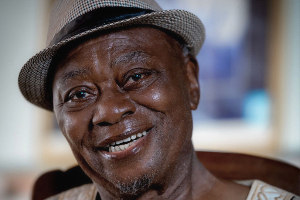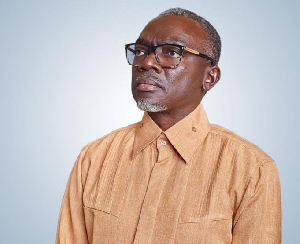: a Socio-economic Burden
By Alex Ababio
This article takes a look at a brief history of Ghana's chronic disease burden over the last five decades, focusing on prevalence, risk and illness experiences and more especially the expensive cost in treating Chronic Kidney Diseases (CKD). Two points of views are expressed here. First, chronic diseases in Ghana comprise public health and developmental challenges, which calls for the same intellectual and financial commitments afforded to communicable and infectious diseases such as Malaria and HIV/AIDS. Second, appreciate multifaceted roots and consequences of chronic diseases, particularly CKD, research, interventions and policies to be informed by multidisciplinary - biomedical and social science - collaborations.
Available evidence: Prevalence, morbidity and mortality
Chronic diseases have a longer history in Ghana than is usually known. Cancer of the liver was recorded in 1817 in Asante communities; sickle cell disease was described in 1866. Cases of stroke were presented and treated at Korle-Bu hospital in Accra when it opened in the 1920s. Between the 1920s and the 1960s data gathered from Korle-Bu hospital showed a steady increase of stroke and cardiovascular diseases. Hospital-based and community-based studies conducted since the 1950s provide important information on prevalence and morbidity trends for , hypertension, diabetes, cancers a sickle cell disease and Kidney Failure. During the same period (1950s to present) major causes of death have shifted from solely communicable diseases to a combination of communicable and chronic non-communicable diseases. In Accra, cardiovascular diseases rose from being the seventh and tenth cause of death in 1953 and 1966 respectively, to becoming the number one cause of death in 1991 and 2001.By 2003 at least four conditions - stroke, hypertension, diabetes ,cancer Chronic Kidney Diseases - had become one of the top ten causes of death in at least each regional health facility.
INTRODUCTION
Chronic renal failure (CRF), or end-stage renal disease, is a progressive debilitating illness which requires treatment options, such as dialysis. The types of dialysis include peritoneal dialysis and haemodialysis. Other treatment options are kidney transplants and interventions, such as education on lifestyle alterations, dietary and fluid restrictions (WFRC, 2000:1). Patients’ quality of life, physical and mental health, independence, general well-being, personal relationships and social functioning might be affected by end-stage renal disease. The number of people diagnosed with chronic kidney diseases and requiring dialysis treatment is on the increase (United Kingdom and United States Renal Data System, 2004:1).
According to World Health Organisation ,WHO, 2002 World Health Repor,’’Reducing Risks,Promoting Healthy
Life ‘’ 21,000 children, under four years were killed by Kidney and Urinary Tract Diseases.13,000 children within five to 13 years lost their lives through the disease.45,000 people with age group between 15 and 29 suffered the same fate. The report further stated that 72,000 people within 30 to 44 years died as a result of the disease and 141,000 also lost their lives through Kidney and Urinary Tract Diseases.Another 152,000 people under 60 to 69 years perished and the rest were 195,000 people with age group 70 to 79 and 186,000 people from 80 years upwards lost their lives through the diseases.In this report it was identified that Unmodifiable factors were considered to include old age, genetics and ethnicity.
According to Mate-Kole (2007:1), there is an epidemic of kidney disease in Ghana where increasing numbers of end-stage renal patients require haemodialysis. He further states that 10% of all medical admissions have CRF. Haemodialysis is the main treatment option since peritoneal dialysis is not done in Ghana, and until recently, renal transplants were also not done in the country. Haemodialysis is carried out in only three hospitals in Ghana. Available records at the Kole-Bu Teaching Hospital as of May 2008 revealed that 65 end-stage renal disease patients were undergoing haemodialysis, compared to 48 the previous year. According to Mate-Kole (2007:1), there are a number of end-stage renal disease patients in Ghana who need haemodialysis but cannot afford it. The high cost of haemodialysis in the country places it beyond the reach of many, except the very rich, and those working with reputable companies who belong to prepaid medical aid schemes.
According to data obtained from the Disease Control Priority Project ,Kidney disease and kidney failure are rising globally, particularly in developing countries where the major underlying causes, diabetes and hypertension, are also on the rise. As with all chronic diseases, chronic kidney disease places long-term demands on health care systems. Patients with advanced stages of the disease need some form of renal (kidney) replacement therapy, but the increased demand is unlikely to be met in developing countries because of the complexity and high cost of such therapy. Thus, detecting kidney disease early and managing the underlying causes are key to saving lives.
What Are the Causes and Risk Factors?
In developing countries such as Ghana, some kidney diseases result from infectious conditions, such as malaria, schistosomiasis (a parasitic infection), and hepatitis B. However, as the populations of developing countries grow older and become more affluent, non communicable diseases are rising rapidly and bringing with them a rise in kidney disease.
PROBLEMS
Financial burden is also a problem. In Ghana, the cost of dialysis, initial laboratory investigations and medications per year is GH¢42,000 which is equivalent to $28,000, and each session of dialysis costs €100 (an equivalent of GH¢120). Most of these patients are their families’ bread winners, and sometimes their need to survive (by paying for haemodialysis sessions) might compromise the finances of their families.
Thirty-five year old Mavis Owusu Asamoah of Kumasi who was diagnosed of End-Stage Renal Disease which requires kidney transplant at the Korle-Bu Teaching Hospital to save her was unable to afford the cost.She as result appealed for donor support to enable her undergo the transplanting surgery. Mavis is lucky because someone is ready to donate a kidney, but the cost won't let it happen.
Korle-Bu has 135 patients who are regularly on dialysis due to kidney disease. The youngest is eight years old and the oldest is in his 70s. The hospital has 18 dialysis machines. “These machines are under real pressure,” says Dr Osafo. “In the near future they will break down.”
A basic dialysis machine costs about $20,000.
In Ghana, renal disease has a low priority for healthcare planners due to concentration on other diseases, such as HIV/AIDS, tuberculosis and malaria. Consequently, psychosocial assessment and support, part of the nurse’s role in caring for haemodialysis patients, might be neglected at some haemodialysis units. Few studies have been conducted on patients’ psychosocial experiences while undergoing haemodialysis in Ghana. Feelings of depression were evident in the words of a 38-year old Kidney patient who stated: ‘’Occasionally I become depressed, but I don’t experience it quite often. Sometimes I ask myself why me? Why is this happening to me? A lot of people are just walking on the streets freely; they drink as and when they want to, and they are able to urinate freely, but as for me, I have to come for dialysis to be helped to urinate, and when I think about these things, I become depressed, and I keep on asking how come?’’
Social experiences
Inability to attend social functions (such as funerals, parties, church services); impact of dialysis treatment on relationships with family and friends; and the attitudes of family members towards patients.Most patients (8 out of 10) stated that their sexual lives had been affected by haemodialysis. This was evident in the words of a 56-year-old man who stated: ‘’My marriage has been stable, but my only problem is with sex. I don’t think I’m being able to satisfy my wife sexually. The treatment has decreased my sexual life and activity. The feeling to have sex is always there, but you are not able to perform as before. Erection is also not as strong as I want it to be. Another problem is that my wife is always afraid. Once we tried it and I nearly collapsed so she doesn’t want me to do it at all. She’s afraid I will collapse’’
Economic encounters
Financial problems have been indicated by caregivers of haemodialysis patients in the study by Ferrario et al. (2002) and haemodialysis patients (Harwood et al., 2005; Kelly et al., 2003). This is an indication that haemodialysis treatment does not only affect the patients. all 10 patients I interviewed told me they faced economic challenges, such as loss of income, lowered productivity, dependence on other people and difficulties to pay for the dialysis treatment and for expensive medications. Although some patients were sponsored by their employers and medical aid schemes, they had to pay for drugs and laboratory investigations. A 62-year-old woman lamented:
‘’The financial aspect is the most difficult thing, because I come here three times in a week and one session of dialysis is about 100 Euros so it’s 300 Euros a week. Apart from that you also have to be given injections three times every week and now one injection is over one hundred Ghana cedis($50.00). After the injection you have to buy drugs and if BP is also not stable, you also have to buy BP drugs so it’s very expensive. Also it’s an unsustainable condition and one person cannot bear the cost of treatment alone’’.
Physical experiences
Most of the patients stressed that they always encountered many physical problems, such as sleep disturbances, fluid and diet restrictions, problems accessing the treatment site and their experiences in the dialysis unit. All of the 10 patients I spoke to indicated that they experienced physical symptoms such as weakness, loss of appetite, general bodily pains, dizziness and breathlessness. The following are some of the excerpts from some patients’:
‘’I often experience general weakness. I feel so weak that I cannot even carry a bucket of water. When you lift it, you feel as if you are falling down. I often lose appetite and sometimes have to force myself to eat because I’ve been taking drugs. At times I experience nausea, and don’t have appetite for food especially when your urea builds up.
Once in a while you have joint pains all over your body especially when your calcium level falls. Some days are usually bad, but I think I’m okay. Sometimes I feel dizzy especially after dialysis, and sway when I’m walking. I also feel dizzy when I’m walking at night.
There was a time I tried having sexual intercourse with my wife and after the act I became breathless and my wife had to fan me. That has discouraged me from having an affair with my wife’’.
All the 10 patients indicated that they had problems with food and fluid restrictions. This finding is in line with a study carried out by Mok and Tam (2001) in Hong Kong which reported that haemodialysis patients experience fluid and food restrictions as stressors.
One patient remarked :
‘’The fluid restriction is very difficult, uncomfortable and tempting. Sometimes you feel thirsty and you want to have a drink, but you cannot have enough, and you cannot also take beer or fanta. You have to watch your fluid intake and so you control it until you do your dialysis. If you drink fanta or a small bottle of beer today, it means you can’t take it tomorrow because you’ve taken in too much already and these are very terrible situations for us’’.
Experiences at the dialysis unit Even though most patients provided good reports about the renal unit, a few had mixed feelings about the staff members’ attitudes, as indicated by the following excerpts:
The nurses, I will say have their own problems just as we as dialysis patients. On a good day the nurses will smile and crack jokes; at some other times you come and they are cold toward you. But I think on the whole I am okay with the unit. You know we are human beings and sometimes we can also be troublesome, so by all means in one way or the other, the nurses get offended, but you cannot complain. Patients reported that they occasionally encountered a few problems at the unit, such as water shortage and power or electricity cuts.
Interventions
Primary prevention strategies must be at the forefront of the regional fight to reduce prevalence rates. Preventive measures are by far the most effective and cost effective ways to slow the progression of CKD. Primary prevention measures include improving the nutrition of adolescent girls and pregnant women; reducing saturated fats in the diet; increasing exercise; stopping smoking; and controlling blood sugar in diabetics. Dr Isaac Kofi Owusu a Consultant Cardiologist at the Department of Medicine of the Komfo Anokye Teaching Hospital, KATH in Kumasi stressed that a change from active lifestyle to that of sedentary life style among Ghanaians has accounted for the increasing trend of cardiovascular disease and other resultant complications. .He therefore advised Ghanaians to stop eating fat food, high content of cholesterol and salt, adding that it was risky for eating fast food since it increases the chances for one to develop hypertension,obesity and complicated heart diseases.
‘’ It is beneficial for Ghanaians to eat a lot of vegetables and fruits and do a lot of physical exercise,atleast under take an hour walk every day’’. Kidney transplants are the most cost-effective way to save the lives of those with end-stage renal disease. Transplant costs are about $10,000 in developed countries, and less in developing countries such as India, where a transplant may range from $1,500 to $7,000. However, the availability of kidneys is a limiting factor, as many countries lack an organized program for identifying donors and retrieving the organs. Moreover, patients who do receive a transplant face ongoing costs of up to $3,000 per year for drugs to suppress their immune systems and prevent rejection of the transplanted organ. Dialysis filtering waste products from the blood is readily available in the industrialized world and is covered by government or private health insurance. But it is the most costly treatment option, at approximately $60,000 per year at a center and $40,000 in developed countries. More than 120 countries have dialysis programs, but relatively few people benefit from them. Dialysis is most cost-effective if used as an interim measure before a kidney transplant.
Prevention strategies:
Community level
Chronic disease prevention at community level should ideally encompass activities of the following key actors: primary health care services, voluntary organizations, the food industry and supermarkets, work sites, schools and the local media.. The mass media is a key site for disseminating information on chronic diseases in Ghana. Individual level Despite challenges to chronic disease treatment and management in Ghana, there is evidence of innovative care. The clinic's approach has led to increased trust and improved communication between patients and health professionals and created an important space for group education and psychosocial support.
Recommendations
A Consultant Paediatric Physiologist at Komfo Anokye Hospital in Kumasi,Dr Sampson Antwi shared the same view with a suggestions from Disease Control Priority Project that Kidney failure imposes a high and growing cost to health systems that few developing countries can afford. Therefore prevention measures which have proven to work well, should be disseminated widely to ensure more lives are saved.
He continued :’’ Expand surveillance of kidney disease in developing countries by supporting epidemiological studies in selected countries and by establishing an international kidney disease data center’’. ‘’Promote public awareness in the country about the early signs of kidney disease and ways to prevent its progression’. ‘ Focus more attention on reducing the prevalence of diabetes and hypertension, and develop kidney programs in that context.Train and update physicians, nurses, and other health professionals to detect kidney disease and Promote preventive measures’’.
‘’Develop centers of excellence for Data Processing , education, training,clinical care, and prevention and treatment of kidney disease, located in all ten regions in the country and funded by international, national, and nongovernmental agencies. These centers should be closely linked to international centers for cardiovascular disease and diabetes’’,he noted
Policy development
Dr Isaac Kofi Owusu a Consultant Cardiologist at the Department of Medicine of the Komfo Anokye Teaching Hospital, KATH in Kumasi stated :’’It is well documented that the development of local health policies is often influenced by the priorities and ideologies of international health initiatives and Africa's development partners. These factors are often compounded by poor leadership and governance’’. ‘’The establishment of the health Millennium Development Goals (MDGs) as a gold standard of measuring outcomes in global population health and of international funding and monitoring initiatives such as the Global Fund is a recent case in point. In many African countries, health policy makers prioritise public health problems identified by the health MDGs such as HIV/AIDS, tuberculosis and malaria and neglect important public health problems that are not explicitly mentioned by the health MDGs, even when prevalence, morbidity and mortality rates of chronic disease group far outweigh that of the former group’’.
‘’In Ghana there is a significant gap between policy rhetoric and action. Despite almost two decades of policy discussions on the need for a chronic disease policy, there is no concrete policy or plan. Although a non-communicable disease control programme has been established which advocates a public health model, the programme lacks the professional and material capacity to achieve its goals’’. This status quo should be changed to embrace a more innovative approach which include multifaceted and social science collaboration to solve the problem.
Opinions of Sunday, 13 October 2013
Columnist: Ababio, Alex


















